Sotiris Ioannidis
Realizing RF Wavefront Copying with RIS for Future Extended Reality Applications
Jun 11, 2024



Abstract:Lately a new approach to Extended Reality (XR), denoted as XR-RF, has been proposed which is realized by combining Radio Frequency (RF) Imaging and programmable wireless environments (PWEs). RF Imaging is a technique that aims to detect geometric and material features of an object through RF waves. On the other hand, the PWE focuses on the the conversion of the wireless RF propagation in a controllable, by software, entity through the utilization of Reconfigurable Intelligent Surfaces (RISs), which can have a controllable interaction with impinging RF waves. In that sense, this dynamic synergy leverages the potential of RF Imaging to detect the structure of an object through RF wavefronts and the PWE's ability to selectively replicate those RF wavefronts from one spatial location to wherever an XR-RF mobile user is presently located. Then the captured wavefront, through appropriate hardware, is mapped to the visual representation of the object through machine learning models. As a key aspect of the XR-RF's system workflow is the wavefront copying mechanism, this work introduces a new PWE configuration algorithm for XR-RF. Moreover, it is shown that the waveform replication process inevitably yields imprecision in the replication process. After statistical analysis, based on simulation results, it is shown that this imprecision can be effectively modeled by the gamma distribution.
Energy-aware Trajectory Optimization for UAV-mounted RIS and Full-duplex Relay
Jan 22, 2024Abstract:In the evolving landscape of sixth-generation (6G) wireless networks, unmanned aerial vehicles (UAVs) have emerged as transformative tools for dynamic and adaptive connectivity. However, dynamically adjusting their position to offer favorable communication channels introduces operational challenges in terms of energy consumption, especially when integrating advanced communication technologies like reconfigurable intelligent surfaces (RISs) and full-duplex relays (FDRs). To this end, by recognizing the pivotal role of UAV mobility, the paper introduces an energy-aware trajectory design for UAV-mounted RISs and UAV-mounted FDRs using the decode and forward (DF) protocol, aiming to maximize the network minimum rate and enhance user fairness, while taking into consideration the available on-board energy. Specifically, this work highlights their distinct energy consumption characteristics and their associated integration challenges by developing appropriate energy consumption models for both UAV-mounted RISs and FDRs that capture the intricate relationship between key factors such as weight, and their operational characteristics. Furthermore, a joint time-division multiple access (TDMA) user scheduling-UAV trajectory optimization problem is formulated, considering the power dynamics of both systems, while assuring that the UAV energy is not depleted mid-air. Finally, simulation results underscore the importance of energy considerations in determining the optimal trajectory and scheduling and provide insights into the performance comparison of UAV-mounted RISs and FDRs in UAV-assisted wireless networks.
Russo-Ukrainian War: Prediction and explanation of Twitter suspension
Jun 06, 2023



Abstract:On 24 February 2022, Russia invaded Ukraine, starting what is now known as the Russo-Ukrainian War, initiating an online discourse on social media. Twitter as one of the most popular SNs, with an open and democratic character, enables a transparent discussion among its large user base. Unfortunately, this often leads to Twitter's policy violations, propaganda, abusive actions, civil integrity violation, and consequently to user accounts' suspension and deletion. This study focuses on the Twitter suspension mechanism and the analysis of shared content and features of the user accounts that may lead to this. Toward this goal, we have obtained a dataset containing 107.7M tweets, originating from 9.8 million users, using Twitter API. We extract the categories of shared content of the suspended accounts and explain their characteristics, through the extraction of text embeddings in junction with cosine similarity clustering. Our results reveal scam campaigns taking advantage of trending topics regarding the Russia-Ukrainian conflict for Bitcoin and Ethereum fraud, spam, and advertisement campaigns. Additionally, we apply a machine learning methodology including a SHapley Additive explainability model to understand and explain how user accounts get suspended.
BotArtist: Twitter bot detection Machine Learning model based on Twitter suspension
Jun 02, 2023Abstract:Twitter as one of the most popular social networks, offers a means for communication and online discourse, which unfortunately has been the target of bots and fake accounts, leading to the manipulation and spreading of false information. Towards this end, we gather a challenging, multilingual dataset of social discourse on Twitter, originating from 9M users regarding the recent Russo-Ukrainian war, in order to detect the bot accounts and the conversation involving them. We collect the ground truth for our dataset through the Twitter API suspended accounts collection, containing approximately 343K of bot accounts and 8M of normal users. Additionally, we use a dataset provided by Botometer-V3 with 1,777 Varol, 483 German accounts, and 1,321 US accounts. Besides the publicly available datasets, we also manage to collect 2 independent datasets around popular discussion topics of the 2022 energy crisis and the 2022 conspiracy discussions. Both of the datasets were labeled according to the Twitter suspension mechanism. We build a novel ML model for bot detection using the state-of-the-art XGBoost model. We combine the model with a high volume of labeled tweets according to the Twitter suspension mechanism ground truth. This requires a limited set of profile features allowing labeling of the dataset in different time periods from the collection, as it is independent of the Twitter API. In comparison with Botometer our methodology achieves an average 11% higher ROC-AUC score over two real-case scenario datasets.
Zero-Energy Reconfigurable Intelligent Surfaces (zeRIS)
May 12, 2023Abstract:A primary objective of the forthcoming sixth generation (6G) of wireless networking is to support demanding applications, while ensuring energy efficiency. Programmable wireless environments (PWEs) have emerged as a promising solution, leveraging reconfigurable intelligent surfaces (RISs), to control wireless propagation and deliver exceptional quality-ofservice. In this paper, we analyze the performance of a network supported by zero-energy RISs (zeRISs), which harvest energy for their operation and contribute to the realization of PWEs. Specifically, we investigate joint energy-data rate outage probability and the energy efficiency of a zeRIS-assisted communication system by employing three harvest-and-reflect (HaR) methods, i) power splitting, ii) time switching, and iii) element splitting. Furthermore, we consider two zeRIS deployment strategies, namely BS-side zeRIS and UE-side zeRIS. Simulation results validate the provided analysis and examine which HaR method performs better depending on the zeRIS placement. Finally, valuable insights and conclusions for the performance of zeRISassisted wireless networks are drawn from the presented results.
An Open Platform for Simulating the Physical Layer of 6G Communication Systems with Multiple Intelligent Surfaces
Nov 03, 2022Abstract:Reconfigurable Intelligent Surfaces (RIS) constitute a promising technology that could fulfill the extreme performance and capacity needs of the upcoming 6G wireless networks, by offering software-defined control over wireless propagation phenomena. Despite the existence of many theoretical models describing various aspects of RIS from the signal processing perspective (e.g., channel fading models), there is no open platform to simulate and study their actual physical-layer behavior, especially in the multi-RIS case. In this paper, we develop an open simulation platform, aimed at modeling the physical-layer electromagnetic coupling and propagation between RIS pairs. We present the platform by initially designing a basic unit cell, and then proceeding to progressively model and simulate multiple and larger RISs. The platform can be used for producing verifiable stochastic models for wireless communication in multi-RIS deployments, such as vehicle-to-everything (V2X) communications in autonomous vehicles and cybersecurity schemes, while its code is freely available to the public.
Evaluating Short-Term Forecasting of Multiple Time Series in IoT Environments
Jun 15, 2022
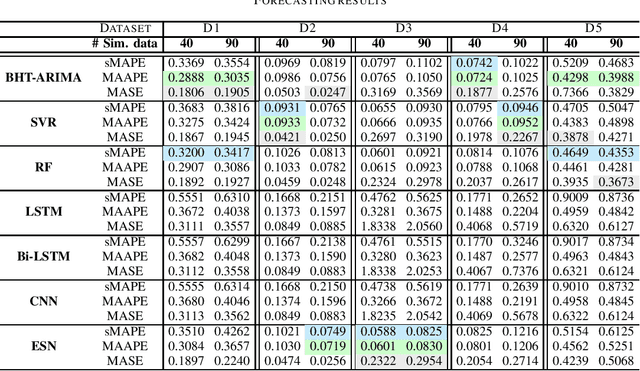
Abstract:Modern Internet of Things (IoT) environments are monitored via a large number of IoT enabled sensing devices, with the data acquisition and processing infrastructure setting restrictions in terms of computational power and energy resources. To alleviate this issue, sensors are often configured to operate at relatively low sampling frequencies, yielding a reduced set of observations. Nevertheless, this can hamper dramatically subsequent decision-making, such as forecasting. To address this problem, in this work we evaluate short-term forecasting in highly underdetermined cases, i.e., the number of sensor streams is much higher than the number of observations. Several statistical, machine learning and neural network-based models are thoroughly examined with respect to the resulting forecasting accuracy on five different real-world datasets. The focus is given on a unified experimental protocol especially designed for short-term prediction of multiple time series at the IoT edge. The proposed framework can be considered as an important step towards establishing a solid forecasting strategy in resource constrained IoT applications.
Twitter Dataset on the Russo-Ukrainian War
Apr 07, 2022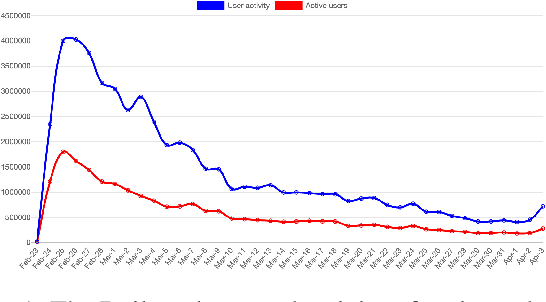
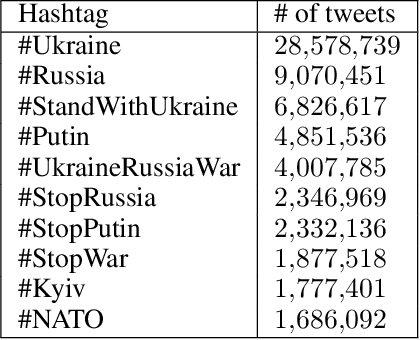
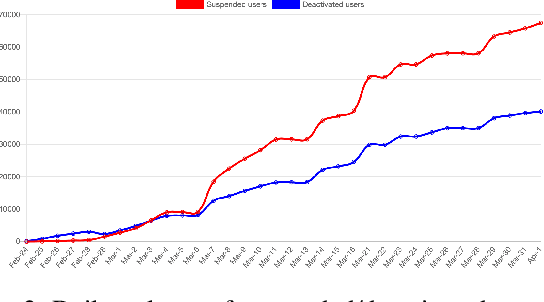
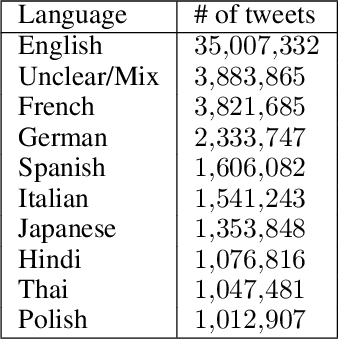
Abstract:On 24 February 2022, Russia invaded Ukraine, also known now as Russo-Ukrainian War. We have initiated an ongoing dataset acquisition from Twitter API. Until the day this paper was written the dataset has reached the amount of 57.3 million tweets, originating from 7.7 million users. We apply an initial volume and sentiment analysis, while the dataset can be used to further exploratory investigation towards topic analysis, hate speech, propaganda recognition, or even show potential malicious entities like botnets.
Identification of Twitter Bots Based on an Explainable Machine Learning Framework: The US 2020 Elections Case Study
Dec 14, 2021



Abstract:Twitter is one of the most popular social networks attracting millions of users, while a considerable proportion of online discourse is captured. It provides a simple usage framework with short messages and an efficient application programming interface (API) enabling the research community to study and analyze several aspects of this social network. However, the Twitter usage simplicity can lead to malicious handling by various bots. The malicious handling phenomenon expands in online discourse, especially during the electoral periods, where except the legitimate bots used for dissemination and communication purposes, the goal is to manipulate the public opinion and the electorate towards a certain direction, specific ideology, or political party. This paper focuses on the design of a novel system for identifying Twitter bots based on labeled Twitter data. To this end, a supervised machine learning (ML) framework is adopted using an Extreme Gradient Boosting (XGBoost) algorithm, where the hyper-parameters are tuned via cross-validation. Our study also deploys Shapley Additive Explanations (SHAP) for explaining the ML model predictions by calculating feature importance, using the game theoretic-based Shapley values. Experimental evaluation on distinct Twitter datasets demonstrate the superiority of our approach, in terms of bot detection accuracy, when compared against a recent state-of-the-art Twitter bot detection method.
An Interpretable Neural Network for Configuring Programmable Wireless Environments
May 07, 2019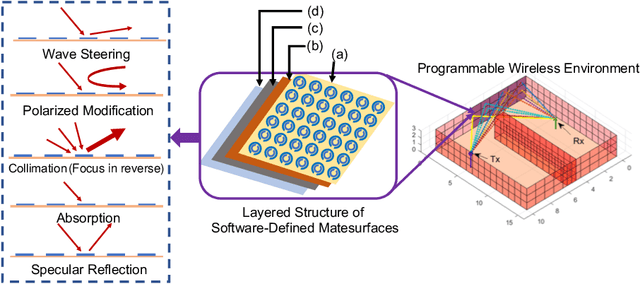
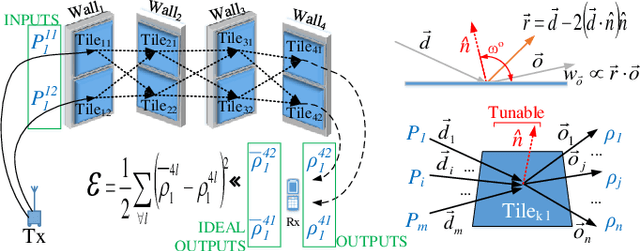
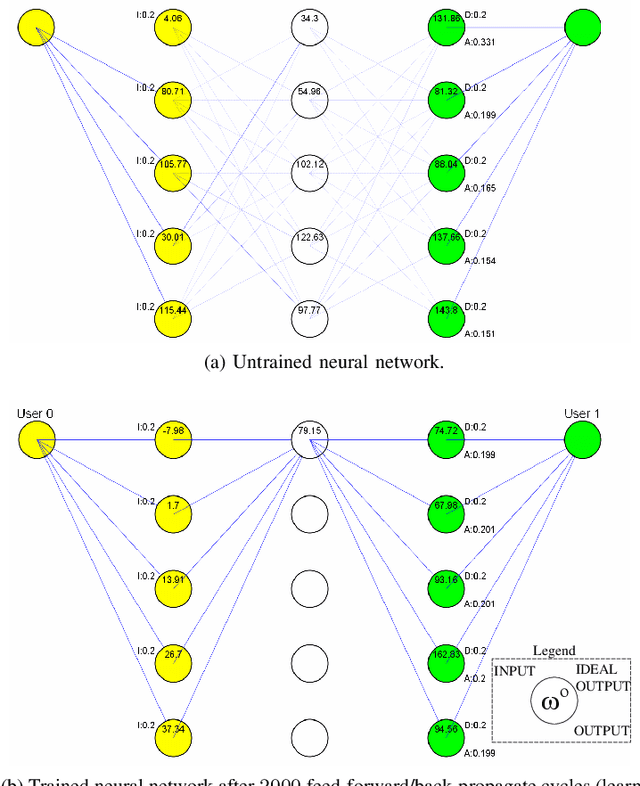
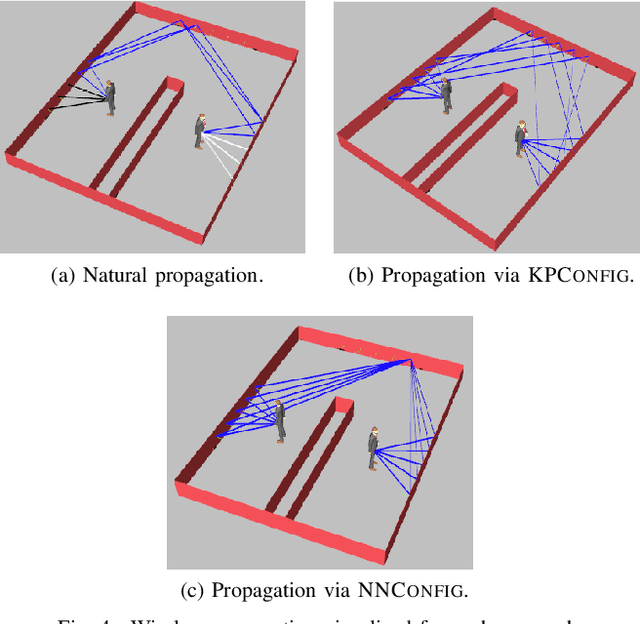
Abstract:Software-defined metasurfaces (SDMs) comprise a dense topology of basic elements called meta-atoms, exerting the highest degree of control over surface currents among intelligent panel technologies. As such, they can transform impinging electromagnetic (EM) waves in complex ways, modifying their direction, power, frequency spectrum, polarity and phase. A well-defined software interface allows for applying such functionalities to waves and inter-networking SDMs, while abstracting the underlying physics. A network of SDMs deployed over objects within an area, such as a floorplan walls, creates programmable wireless environments (PWEs) with fully customizable propagation of waves within them. This work studies the use of machine learning for configuring such environments to the benefit of users within. The methodology consists of modeling wireless propagation as a custom, interpretable, back-propagating neural network, with SDM elements as nodes and their cross-interactions as links. Following a training period the network learns the propagation basics of SDMs and configures them to facilitate the communication of users within their vicinity.
 Add to Chrome
Add to Chrome Add to Firefox
Add to Firefox Add to Edge
Add to Edge